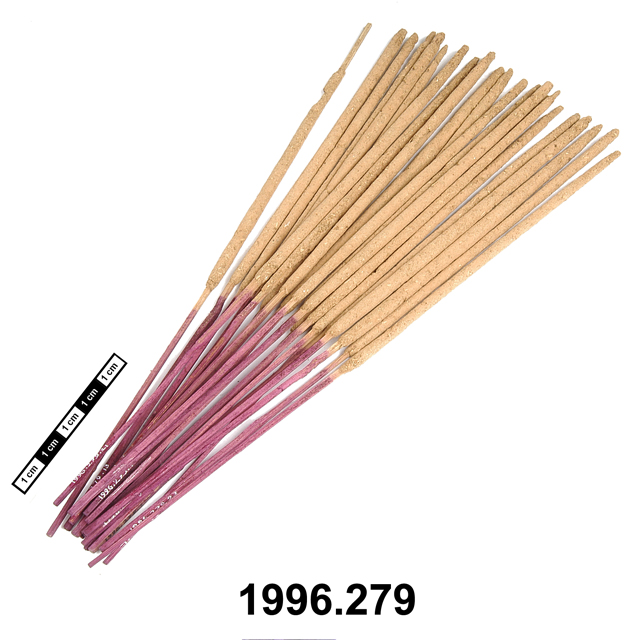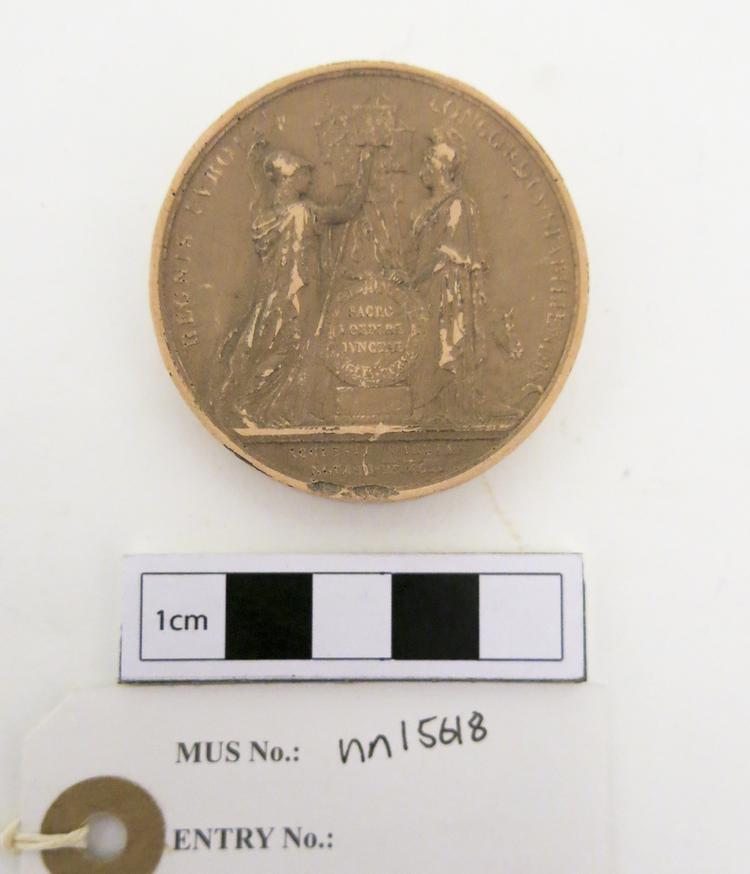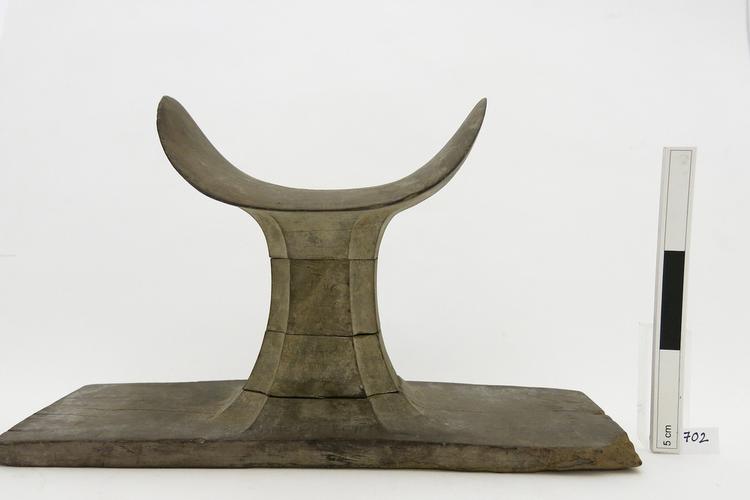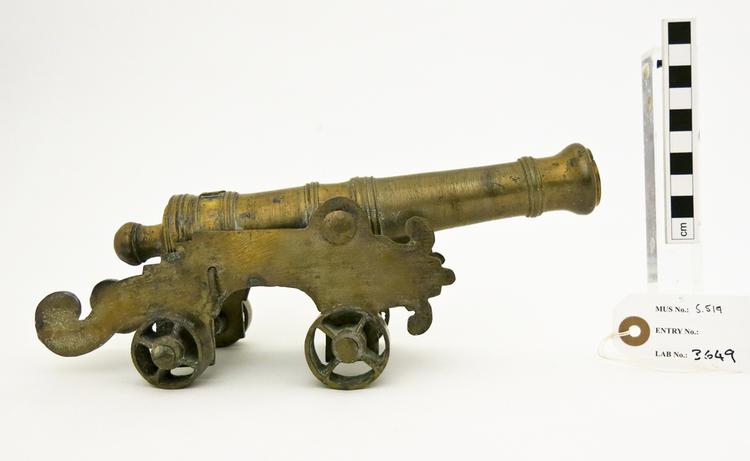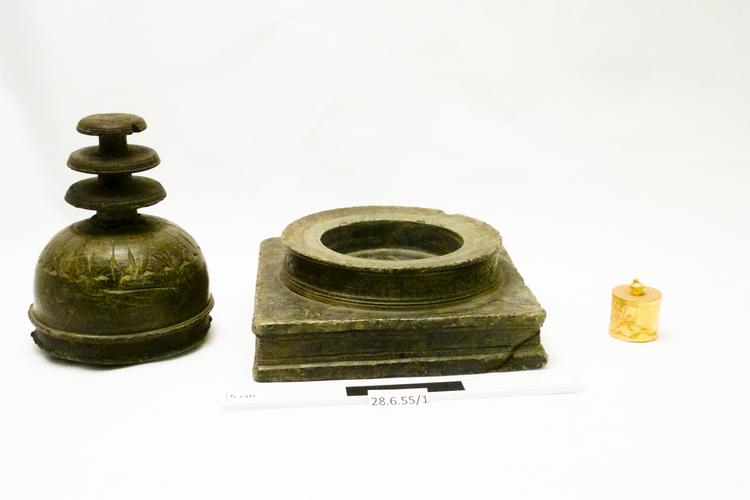

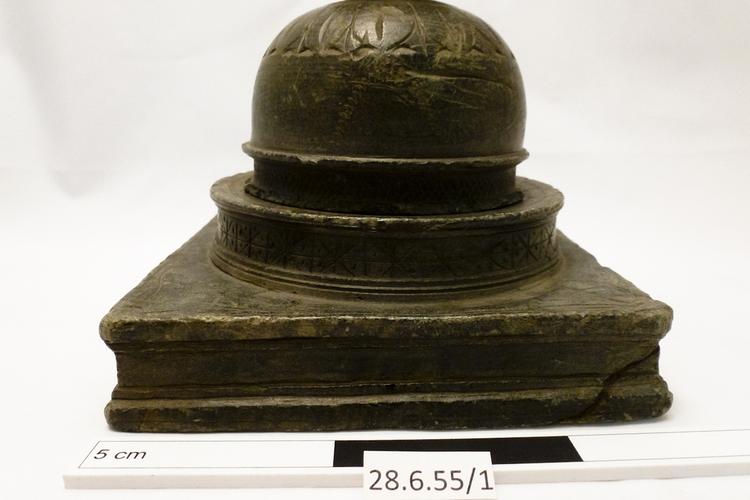

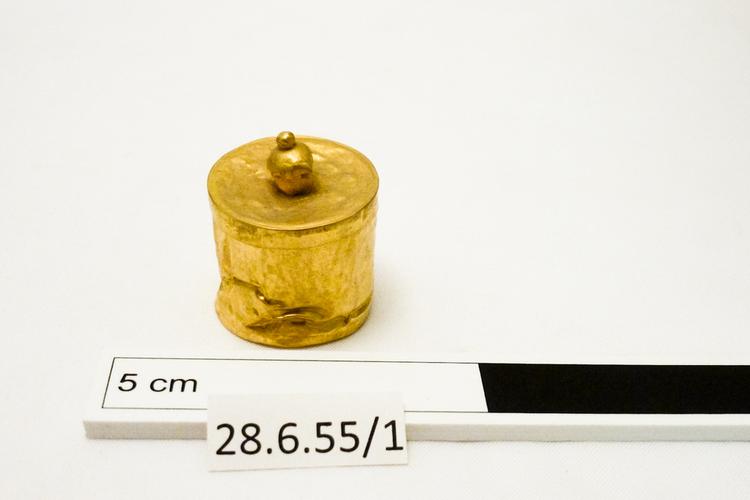

A reliquary set consisting of a stupa-shaped dome with umbrellas and platform, in two separate pieces, both in greenish steatite, the dome acting as a hollow cover to the small round chamber on the top of the platform. Within the chamber is a small cylindrical gold box with cover and a double knob, originally meant for storage of a quantity of relics from the person memorialised in the larger stupa, and within which this casket complex was deposited in ancient times. The group of three honorific umbrellas is made in a steatite darker than the main reliquary. It is attached to the dome of the box, its square base set into a square hollow on the top of the dome. An x-ray conducted by the Horniman reveals a screw and a washer linking the dome and umbrella base, thus demonstrating that the umbrellas and the dome were not associated in antiquity. Although this combination is a modern palimpsest (i.e. ca.1930s or so), both parts of the combination do seem to be genuine? Gandharan reliquaries usually (not always) include the harmika or ceremonial enclosure at the base of the umbrella shaft. The Horniman example lacks this important feature but even without it there is no reason to doubt its genuineness.
The gold box is empty and it is slightly crushed on one side. XRF analysis conducted at the Horniman reveals that the gold is of exceptionally high quality (composition: gold 98.4 %, silver 0.7 %. bismuth 0.6 % and lead 0.6%).
The dome is decorated at its summit with a series of engraved hanging lotus petals above a wide zone empty save for an undulating garland indicated by wavy lines. The narrow zone at the bottom of the dome is decorated with incised cross-hatching. The upper vertical zone of the platform is decorated with a series of squares filled with vertical and diagonal crosses and dots.
Date: circa 1st or 2nd century.
From an unknown site in the part of North West Pakistan now known as Khyber Pakhtunkhwa, but in ancient times known as Gandhara. The famous standing bronze Buddha from Gandhara, now in the British Museum, but originally owned by General Haughton, was found in the excavation for a house foundation at Sari Bahlol, Mardan District. This is the kind of geographic area from which this reliquary might have come though there is no specific mention anywhere of its precise find spot. Clearly the reliquary has been removed from the heart of a Buddhist stupa from somewhere in the Gandharan region (and most likely in the Mardan/Charsadda area).
Purchased from: Major General Henry Lawrence Haughton (1883 – 1955) (Indian Army).
A reliquary set consisting of a stupa-shaped dome with umbrellas and platform, in two separate pieces, both in greenish steatite, the dome acting as a hollow cover to the small round chamber on the top of the platform. Within the chamber is a small cylindrical gold box with cover and a double knob, originally meant for storage of a quantity of relics from the person memorialised in the larger stupa, and within which this casket complex was deposited in ancient times. The group of three honorific umbrellas is made in a steatite darker than the main reliquary. It is attached to the dome of the box, its square base set into a square hollow on the top of the dome. An x-ray conducted by the Horniman reveals a screw and a washer linking the dome and umbrella base, thus demonstrating that the umbrellas and the dome were not associated in antiquity. Although this combination is a modern palimpsest (i.e. ca.1930s or so), both parts of the combination do seem to be genuine? Gandharan reliquaries usually (not always) include the harmika or ceremonial enclosure at the base of the umbrella shaft. The Horniman example lacks this important feature but even without it there is no reason to doubt its genuineness. The gold box is empty and it is slightly crushed on one side. XRF analysis conducted at the Horniman reveals that the gold is of exceptionally high quality (composition: gold 98.4 %, silver 0.7 %. bismuth 0.6 % and lead 0.6%). The dome is decorated at its summit with a series of engraved hanging lotus petals above a wide zone empty save for an undulating garland indicated by wavy lines. The narrow zone at the bottom of the dome is decorated with incised cross-hatching. The upper vertical zone of the platform is decorated with a series of squares filled with vertical and diagonal crosses and dots. Date: circa 1st or 2nd century. From an unknown site in the part of North West Pakistan now known as Khyber Pakhtunkhwa, but in ancient times known as Gandhara. The famous standing bronze Buddha from Gandhara, now in the British Museum, but originally owned by General Haughton, was found in the excavation for a house foundation at Sari Bahlol, Mardan District. This is the kind of geographic area from which this reliquary might have come though there is no specific mention anywhere of its precise find spot. Clearly the reliquary has been removed from the heart of a Buddhist stupa from somewhere in the Gandharan region (and most likely in the Mardan/Charsadda area). Purchased from: Major General Henry Lawrence Haughton (1883 – 1955) (Indian Army).



